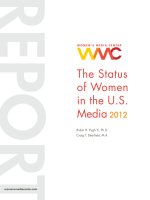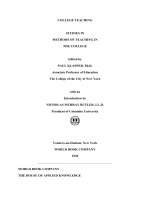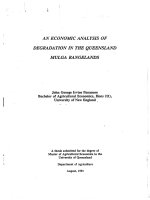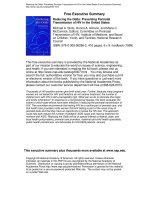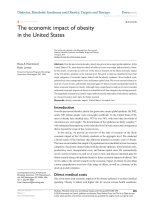university press of florida archaeological studies of gender in the southeastern united states mar 2001
Bạn đang xem bản rút gọn của tài liệu. Xem và tải ngay bản đầy đủ của tài liệu tại đây (2.46 MB, 241 trang )
Archaeological Studies
of Gender in the
Southeastern United
States
University Press of Florida
Edited by
Jane M. Eastman and
Christopher B. Rodning
Acknowledgments / i
S
T
A
T
E
U
N
I
V
E
R
S
I
T
Y
S
Y
S
T
E
M
U
N
I
V
E
R
S
I
T
Y
P
R
E
S
S
O
F
F
L
O
R
I
D
A
UWF
FSU
FAMU
UNF
UF
UCF
USF
FGCU
FAU
FIU
Florida A&M University, Tallahassee
Florida Atlantic University, Boca Raton
Florida Gulf Coast University, Ft. Myers
Florida International University, Miami
Florida State University, Tallahassee
University of Central Florida, Orlando
University of Florida, Gainesville
University of North Florida, Jacksonville
University of South Florida, Tampa
University of West Florida, Pensacola
Archaeological Studies of Gender in the Southeastern United States
The Ripley P. Bullen Series
Florida Museum of Natural History
Archaeological Studies of Gender
in the Southeastern
United States
Edited by
Jane M. Eastman and Christopher B. Rodning
Foreword by Jerald T. Milanich, Series Editor
University Press of Florida
Gainesville · Tallahassee · Tampa · Boca Raton
Pensacola · Orlando · Miami · Jacksonville · Ft. Myers
Copyright 2001 by the Board of Regents of the State of Florida
Printed in the United States of America on acid-free paper
All rights reserved
06 05 04 03 02 01 6 5 4 3 2 1
Library of Congress Cataloging-in-Publication Data
Archaeological studies of gender in the southeastern United States /
edited by Jane M. Eastman and Christopher B. Rodning; foreword by
Jerald T. Milanich.
p. cm. — (The Ripley P. Bullen series)
Includes bibliographical references and index.
ISBN 0-8130-1875-7 (cloth: alk. paper)
1. Indians of North America—Southern States—Antiquities. 2. Indians
of North America—Southern States—Social life and customs.
3. Sex role—Southern States. 4. Southern States—Antiquities. I. Title:
Archaeological studies of gender in the southeastern United States.
II. Eastman, Jane M., 1963–. III. Rodning, Christopher Bernard. IV. Series.
E78.S65 A75 2001
975'.01—dc21 00-047667
The University Press of Florida is the scholarly publishing agency for
the State University System of Florida, comprising Florida A&M
University, Florida Atlantic University, Florida Gulf Coast University,
Florida International University, Florida State University, University of
Central Florida, University of Florida, University of North Florida,
University of South Florida, and University of West Florida.
University Press of Florida
15 Northwest 15th Street
Gainesville, FL 32611–2079
Dedication
This book is dedicated to the memory of Timothy Paul Mooney and Tho-
mas Hargrove. Tim and Tom were both doctoral students in archaeology
at the University of North Carolina in Chapel Hill. Tim died in an acci-
dent near Hillsborough, North Carolina, on an icy day in February 1995.
Tom died suddenly while visiting a museum in downtown Raleigh,
North Carolina, one weekend in October 1999. Both were remarkable
people and talented archaeologists. Both made valuable contributions to
archaeology but had many more to make.
Tim Mooney (1992, 1994, 1995, 1997) was writing his doctoral disserta-
tion at UNC-CH about Choctaw ethnohistory and the archaeology of the
Pearl River Valley in Mississippi, and he had directed archaeological
field schools at Siouan sites near Martinsville, Virginia. His study of
Choctaw culture change and compromise during the sixteenth and sev-
enteenth centuries was published posthumously with an introductory
essay by Vin Steponaitis. The graduate program at North Carolina was
lucky to have him after his successful career as a lawyer in Washington.
His enthusiasm for archaeology, his calm and humble leadership, his de-
pendability, and his rapport with students and colleagues were remark-
able. His family helped to create the Timothy Paul Mooney Fund for
research by graduate students in archaeology at the Research Laborato-
ries of Archaeology in Chapel Hill.
Tom was pursuing Ph.D. research at UNC-CH about Woodland-pe-
riod archaeology along the Roanoke River in southern Virginia, and he
had participated in archaeological studies of European prehistory and
landscape history in Burgundy, France. His study of Piedmont ceramic
traditions was only one of countless contributions that Tom made to ar-
chaeological knowledge of native peoples during every period in every
part of North Carolina. It is difficult to imagine North Carolina archaeol-
vi / Dedication
ogy without Tom. His abiding interest in traditional music and other
folkways, his taste for barbecue and creative potluck gatherings, his vast
but humble knowledge of just about everything, his creative and often
comic command of language, and his quiet but palpable presence and
friendship are unforgettable. Tom had run Archaeological Research Con-
sultants for years from its legendary headquarters at the Forge in down-
town Raleigh.
This book owes much to the inspiration of these men.
Acknowledgments / vii
Contents
List of Figures ix
List of Tables xi
Acknowledgments xiii
Foreword by Jerald T. Milanich, series editor xv
Introduction: Gender and the Archaeology of the Southeast
Christopher B. Rodning and Jane M. Eastman 1
1. Challenges for Regendering Southeastern Prehistory
Cheryl Claassen 10
2. The Gender Division of Labor in Mississippian Households: Its
Role in Shaping Production for Exchange
Larissa Thomas 27
3. Life Courses and Gender among Late Prehistoric Siouan
Communities
Jane M. Eastman 57
4. Mortuary Ritual and Gender Ideology in Protohistoric
Southwestern North Carolina
Christopher B. Rodning 77
5. Those Men in the Mounds: Gender, Politics, and Mortuary
Practices in Late Prehistoric Eastern Tennessee
Lynne P. Sullivan 101
6. Piedmont Siouans and Mortuary Archaeology on the Eno River,
North Carolina
Elizabeth Monahan Driscoll, R. P. Stephen Davis, Jr., and
H. Trawick Ward 127
viii / Contents
7. Auditory Exostoses: A Clue to Gender in Prehistoric and Historic
Farming Communities of North Carolina and Virginia
Patricia M. Lambert 152
8. Concluding Thoughts
Janet E. Levy 173
References 179
Contributors 215
Index 217
Acknowledgments / ix
Figures
I.1. Chapter numbers placed at the locations of study areas in the
Southeast. 2
2.1. Location of Dillow’s Ridge, the Great Salt Spring, and other sites
mentioned in the text. 28
2.2. Mill Creek hoes (after Cobb 1996:270). 35
2.3. Mississippian occupation in the Mill Creek area (after Cobb
1996:276). 36
3.1. Archaeological sites in the upper Dan and Roanoke drainages of
the North Carolina and Virginia Piedmont. 62
3.2. Female-related artifacts from the Stockton site. 68
3.3. Male-related mortuary items from the Stockton site. 69
4.1. Cherokee town groups in southern Appalachia. 78
4.2. Coweeta Creek site in southwestern North Carolina. 79
4.3. Mortuary goods from all graves at the Coweeta Creek site. 92
4.4. Mortuary goods from graves in the Coweeta Creek mound. 92
4.5. Mortuary goods from graves in the Coweeta Creek village. 93
5.1. Demographics of the Toqua burial population. 115
5.2. Adult mound interments at Toqua by age cohort and sex. 116
5.3. Adult village interments at Toqua by age cohort and sex. 117
5.4. Adult individuals associated with funerary objects at Toqua by
age cohorts and sex. 119
5.5. Locations of graves of adult females at Toqua by age cohort. 120
5.6. Locations of graves of adult males at Toqua by age cohort. 121
6.1. Fredricks and other sites mentioned in the text. 128
6.2. Excavation plan of the Fredricks and Jenrette sites showing the
three cemeteries. 129
6.3. Maps of Cemeteries 1, 2, and 3 at Fredricks, showing individual
burial designations. 136
x / Figures
6.4. Maps of Cemeteries 1, 2, and 3 at Fredricks, showing burial
groups and age/sex determinations. 137
6.5. Maps of Cemeteries 1, 2, and 3 at Fredricks, showing the
distribution of funerary objects. 143
6.6. Maps of Cemeteries 1, 2, and 3 at Fredricks, showing the
distribution of decorated garments or adornments. 144
6.7. Chart showing the distribution of funerary objects, decorated
garments, and adornments by age and sex. 145
6.8. Cemeteries and associated refuse-filled pits at Fredricks. 150
7.1. Map of archaeological sites included in the North Carolina/
Virginia study sample. 153
7.2. Auditory exostoses in the North Carolina/Virginia study
sample. 157
7.3. Age distribution of appositional lesions of the external auditory
canal. 161
7.4. Geographic variation in the frequency of auditory exostoses. 163
7.5. Relationship between appositional lesions of the external
auditory canal and cranial deformation. 165
Acknowledgments / xi
Ta bles
1.1. Results of resexing skeletons from the Indian Knoll site in
Kentucky 17
2.1. Summary of identified floral remains from Dillow’s Ridge 38
2.2. Summary of identified faunal remains from Dillow’s Ridge 39
2.3. Lithic tool assemblage from Dillow’s Ridge 41
2.4. Ceramic vessels from Dillow’s Ridge 42
2.5. Summary of identified floral remains from the Great Salt Spring
site 51
2.6. Summary of identified faunal remains from the Great Salt Spring
site 52
3.1. Distribution of mortuary items in burials from late prehistoric
and protohistoric archaeological sites in the Dan and Roanoke
drainages 63
3.2. Distribution of graves with mortuary items 66
3.3. Distribution of sex-specific mortuary items 66
3.4. Distribution of certain mortuary items at late prehistoric and
protohistoric components in the Dan and Roanoke drainages 67
3.5. Frequency of burials with certain mortuary items by sex 70
3.6. Frequency of males by age group 74
3.7. Frequency of burials with certain mortuary items by age group 75
4.1. Excavated graves and grave goods at Coweeta Creek 88
5.1. Mortuary goods from Toqua associated with individuals over the
age of forty 123
6.1. Age, sex, and mortuary attributes for the Fredricks Cemetery
burials 138
6.2. Comparison of pairs of burial groups within the Fredricks
Cemeteries based on artifact content 148
7.1. Samples scored for pathological lesions of the ear canals 156
7.2. Distribution of appositional lesions of the auditory canals 159
7.3. Percentage of individuals with pathological ear conditions by age
group 160
7.4. Sex distribution of auditory exostoses 162
Acknowledgments
This book derives from our symposium about archaeological studies of
gender in southeastern North America, held at the Southeastern Archaeo-
logical Conference in Birmingham, Alabama, in November 1996. Plan-
ning for this symposium must have gotten underway in the midst of
Patricia Crown’s plans for an archaeological symposium about sex roles
and gender hierarchies in the native Southwest, held at the annual meet-
ing of the Society for American Archaeology in Nashville, Tennessee, in
April 1997. Gender is indeed a burgeoning niche within archaeology (see
Nelson 1997). The publication of books about the archaeology of gender
in specific cultural and geographic regions is a welcome contribution to
the anthropological literature (see Kent 1998a). Ours is the first archaeo-
logical book that takes gender in the native Southeast as its main topic.
We hope that it will contribute to further archaeological interests in and
inquiries about gender in native Southeastern societies.
Our inspiration for the symposium and this book came from the gradu-
ate seminar about the archaeology of gender taught in 1996 by Margaret
Scarry at the University of North Carolina at Chapel Hill. We appreciate
her introduction to the archaeological literature about gender and her
abiding interest in this and other of our projects.
Thanks very much to Meredith Morris-Babb for her encouragement
ever since our symposium in 1996 and her interest in having the Univer-
sity Press of Florida publish this book as a contribution to its Ripley P.
Bullen Series with the Florida Museum of Natural History. Judy Goffman
helped us in preparing the final manuscript, and David Graham helped
with the illustrations. We could not have put this book together without
their guidance and the support of many others.
Of course, considerable credit is due our chapter contributors. Their
patience is as commendable as their archaeology is exemplary. We thank
xiv / Acknowledgments
Vin Steponaitis, Trawick Ward, Steve Davis, Margaret Scarry, Nancy
White, Jerald Milanich, and an anonymous reviewer for their comments
about the book. Our thanks go to them and to Ken Sassaman, John Scarry,
Stephen Williams, Tom Maher, David Hally, Lynne Sullivan, David Moore,
Holly Matthews, Patrick Livingood, Tony Boudreaux, Hunter Johnson,
Rob Beck, Hope Spencer, Bram Tucker, Greg Wilson, Marianne Reeves,
Tiffiny Tung, Celeste Gagnon, Randy Daniel, Mark Rees, Joe Herbert,
David Morgan, Mintcy Maxham, Clark Larsen, Patty Jo Watson, Kandi
Detwiler, Theda Perdue, Patricia Samford, Judy Knight, Sara Bon-Harper,
Kathy McDonnell, Amber VanDerwarker, and several fellow graduate
students for their interests in and recommendations about this publica-
tion. Unfortunately, neither Ken Sassaman nor Marianne Reeves were
able to contribute their conference papers to the book. Our thanks go to
Lynne Sullivan for coming aboard after our symposium and to Janet
Levy for ably authoring the epilogue. We are grateful to professors Eliza-
beth Brumfiel and Margaret Conkey for their inspiration and encourage-
ment. We thank our friends and fellow archaeologists Patricia Samford
and Annie Holm for their moral support and helpful brainstorming.
This book owes much to all of these people.
We are also grateful for the patience of our dissertation advisors.
Acknowledgments / xv
Foreword
To understand the past, archaeologists must uncover and interpret the
material remains left by past human cultures. Because human behavior is
patterned, archaeologists search for corresponding patterns in the archae-
ological record. When we can discern such evidence, we can better un-
derstand past human societies and events.
In this volume, Jane M. Eastman and Christopher B. Rodning—both
young scholars trained at the University of North Carolina, Chapel Hill—
focus on gender and how behavior associated with gender appears in the
archaeological record. Women, as well as men, performed activities that
are patterned and that left evidence in archaeological sites. If we are truly
to understand the cultures of people who lived hundreds and even thou-
sands of years ago, we must be cognizant of material evidence that is tied
to female social statuses and roles as well as to those of males. We need to
engender archaeological interpretation. Otherwise, our knowledge of
the past is incomplete.
Archaeological Studies of Gender in the Southeastern United States pre-
sents cutting-edge case studies, actual archaeological and bioarchaeolog-
ical projects, that demonstrate how we can engender archaeology. Using
data excavated from sites, the editors and authors make clear the impor-
tance of such an approach, and they show how it enhances the archaeo-
logical record and our ability to use material remains to learn about past
cultures.
This is an important book, one that breaks new ground. I am pleased
to add it to the Ripley P. Bullen series.
Jerald T. Milanich
Series Editor
Introduction
Gender and the
Archaeology of the Southeast
Christopher B. Rodning and Jane M. Eastman
Written accounts by European men who traveled, traded, and lived
among native groups in the southeastern United States from the six-
teenth through the eighteenth centuries documented a world in which
there were marked differences between the lives of native men and
women (Braund 1993:3–25; Galloway 1995:1–2; Hudson 1976:260–69;
Perdue 1998:17–40). These accounts indicate that boys and girls in native
societies learned different sets of skills and that adult women and men
often conducted their daily lives apart from each other. They also suggest
that men and women tended to hold different leadership roles within
their communities. Given the gender distinctions apparent in native
Southeastern societies during the historic period, the careful consider-
ation of gender dynamics should benefit the archaeological study of na-
tive Southeastern cultures. The essays in this book explore the archaeol-
ogy of gender in the native Southeast (see fig. I.1).
Studying Gender through Archaeology
Gender is related to but not determined by biological sex and age. It de-
fines social categories such as men, women, boys, girls, and others like
the berdache (a native North American who adopts an identity normally
associated with the other sex). Cultural traditions about gender include
significant expectations for the social roles and relationships that men,
2 Rodning and Eastman
Fig. I.1. Chapter numbers placed at the locations of study areas in the Southeast.
Gender and the Archaeology of the Southeast 3
women, and children should adopt at different stages of their lives. In
their daily lives, people may choose to follow these traditions, or they
may bend the rules. In either case, their gender roles and identities are
formulated with reference to society’s expectations. Our viewpoint is
that a person’s gender identity can change during the course of his or
her lifetime. Gender identity is cross-cut by other factors such as a
person’s physical growth, development, and aging and also by pro-
gression through socially defined age classes. Gender and aging are in-
terrelated, culturally defined processes, and the precise relationship be-
tween these processes varies from one culture and community to another.
Gender has become a prominent theme in archaeology during the past
several years (Brumfiel 1992; Claassen 1997; Conkey and Gero 1991;
Crown and Fish 1996; Joyce and Claassen 1997; Kent 1998a; Nelson 1997;
Spector 1993; Spielmann 1995; Whelan 1995; N. M. White 1999; R. P.
Wright 1996a). Archaeologists interested in gender commonly study
gender roles, gender identities, and gender ideologies and how these
aspects of gender are reflected in material culture. Gender roles refer to
the differential participation of men, women, and children in activities
within their communities. Gender identities refer to the social personali-
ties and relationships adopted by men, women, and children at different
stages of their lives. Gender ideologies refer to the status relationships
between members of different gender categories, including all genders
relevant in different cultural settings. These different components of gen-
der have been outlined by Margaret Conkey and Janet Spector (1984:15)
in their landmark essay about gender studies in archaeology. One major
contribution of their essay and other archaeological literature about gen-
der is simply the point that gender is constructed differently in different
cultures and communities. Biological sex, while relevant, is not the sole
determinant of gender.
The study of any of these aspects of gender through archaeology does
not necessarily demand new methodologies, but it does demand new
approaches. Archaeologists already are well attuned to identifying and
evaluating patterns in material culture. Gender can affect these kinds of
patterns significantly. By becoming informed about how gender influ-
ences the lives of people as they form households and community groups,
archaeologists can prepare themselves to recognize clues in the material
record that are indeed related to gender in the past.
Although we are advocating an approach to archaeology that is sensi-
tive to the impact of gender differences on patterns in the archaeological
record, we do not suggest that every shred of archaeological evidence is
4 Rodning and Eastman
laden with gendered meaning and insight about gender in the past. But
if archaeologists discount the archaeological record as relevant to this
anthropological topic at all, they never will notice the patterns in archae-
ological evidence that indeed are pertinent. Archaeologists are accus-
tomed to designing research projects to generate meaningful data sets to
answer a variety of questions. Explicitly considering what roles and rela-
tionships men and women and young and old might have held within
their communities, rather than making untested assumptions about their
gender roles and identities, can enrich archaeological reconstructions of
the past.
Gender as an archaeological topic is embedded within topics that ar-
chaeologists traditionally have studied and will continue to investigate
in the future. As Conkey and Gero (1991:15) have noted, “An engendered
past addresses many long-standing concerns of archaeology: the forma-
tion of states, trade and exchange, site settlement systems and activity
areas, the processes of agriculture, lithic production, food production,
pottery, architecture, ancient art—but throws them into new relief. An
engendered past replaces the focus on the remains of prehistory with a focus on
the people of prehistory; it rejects a reified concept of society or culture as an
object of study, does away with the earliest, the biggest, the best ex-
amples of prehistoric forms, and concentrates instead on the continuities
and dialectics of life, the interpersonal and intimate aspects of social set-
tings that bind prehistoric lives into social patterns” (our italics). The
consideration of gender enriches archaeological approaches to topics
that are and have been major topics of interest in the field.
Another contribution of gender studies to archaeology relates to the
way in which archaeologists write about the past. People are active
agents in their own lives and therefore actively affect the ways their lives
enter into the archaeological record. Archaeologists need heuristic de-
vices like “phases” and “cultures” to sort archaeological evidence in ana-
lytically meaningful ways and to communicate with one another about
them. Archaeologists nevertheless are interested in the experiences of
people and not solely the history of different kinds of material culture. It
is not uncommon to read archaeological essays about adaptive systems
or settlement patterns. It is worth remembering that people constituted
those systems and created those patterns.
Gender studies thus encourage archaeologists to concentrate their ef-
forts toward reconstructing the activities of people in the past. They en-
courage archaeologists to carefully consider aspects of social roles and
identities that people adopt during their lifetimes. They demonstrate that
Gender and the Archaeology of the Southeast 5
gender is not immutable but rather is a dynamic dimension of communi-
ties and cultures which shapes the lives of people and is shaped by them.
The archaeological study of gender is not about women exclusively,
even though many early archaeological studies of gender did concen-
trate on women. As Sarah Milledge Nelson (1997:15) has written, “Given
this definition of gender, it follows that a gendered archaeology consid-
ers both women and men, and any other culturally constructed genders
(for example, berdache). Gender is not a code word for women, and gen-
dered archaeology is not another way of finding women in prehistory
disguised with a more neutral and inclusive term. Both women and
men—people as individuals as well as in groups—become more visible
in studying gender. Other constructed roles, activities, and behaviors,
such as ethnicity, age, and class, may also become visible in the course of
researching gender in archaeology” (italics in original). Gendered per-
spectives in archaeology enrich knowledge about the lives of people in
the past and their interactions with people in other gender groups in their
communities.
The early gender studies in archaeology have served to outline gender
bias in archaeological interpretation and to remedy its traditional em-
phasis on patterns attributed to the lives and activities of men (Wylie
1991a:38–41). The recognition of gender as a significant topic for archaeo-
logical investigation certainly owes much to feminist scholarship and its
critique of archaeological thought and practice (Gilchrist 1994:1–8). Nev-
ertheless, archaeologists need not espouse feminist theory to find valu-
able insights offered in archaeological writing about gender.
Our reading of feminist anthropology and archaeology in the 1980s
and 1990s has led to our recognition that a consideration of gender is a
vital part of reconstructing the past. The consideration of gender has en-
hanced our efforts to understand social structure, social dynamics, and
belief systems in the past. The studies presented here are all indebted to
the ground-breaking scholarship of feminist writers and theorists, even
though the authors in this volume do not write from an overtly feminist
perspective. None of the case analyses focus more intently on the lives of
women than on those of men or children. These chapters simply present
archaeological case studies, focused on Native American cultures of the
southeastern United States, that are based on the perspective that gender
differences held significant meaning for these native peoples. The au-
thors pursue many different questions about the past with reference to
different kinds of archaeological evidence, but all are bound by this
shared premise.
6 Rodning and Eastman
The interpretations presented in the chapters that follow are all en-
riched by a careful consideration of the impact that gender differences
may have had on the lives of people in the past. Their reconstructions are
peopled with men, women, and children who developed patterns of
work, play, and ritual that reflected their gender statuses, and whose
lives followed particular courses due in part to gender. The authors in
this volume have all successfully embedded an explicit consideration of
gender into their studies of the past, enhancing their perspectives on a
variety of topics.
The chapter by Cheryl Claassen identifies several problem areas for
gender studies through archaeology in the Southeast. Claassen (1992,
1997) has long championed gendered perspectives on the past. Her
knowledge about gender in the past and present spans the scholarly lit-
erature about native peoples of the Americas and many other continents.
In this chapter she applies that global familiarity to the tasks of learning
about the past lifeways of native southeastern peoples. Her contribution
to this book challenges archaeologists to revamp their perspectives about
the place of men, women, and children in native southeastern societies.
The essay by Larissa Thomas compares and contrasts the gender divi-
sion of labor in late prehistoric communities of southern Illinois. Thomas
describes archaeological evidence of household organization at Dillow’s
Ridge near Mill Creek and compares it to intrasite patterning at the Great
Salt Spring along the Saline River. She reconstructs patterns of hoe pro-
duction as one part of Mississippian household economies at Dillow’s
Ridge. She contrasts this pattern at Dillow’s Ridge with evidence for
different forms of task specialization at the Great Salt Spring locality.
Thomas thus adds a significant voice to the debate among scholars about
the structure and diversity of Mississippian economies in the North
American midcontinent (Cobb 1989, 1996; Muller 1984, 1986, 1997;
Pauketat 1987, 1989, 1997; Prentice 1983, 1985). Archaeologists may find
evidence of very different gender divisions of labor in Mississippian
communities elsewhere in the Southeast, and here Thomas makes a case
that archaeologists need to explore actively this aspect of Mississippian
economies.
Jane Eastman explores evidence for gender differences during the life
cycle of Siouan-speaking peoples who occupied northwestern North
Carolina and southern Virginia during the late prehistoric period. She
examines the distribution of mortuary items in burials from seven village
sites in the region, and her study reconstructs the dynamic relationship
between gender and age in these communities. First, gender distinctions
Gender and the Archaeology of the Southeast 7
appear to have been recognized among children from a very early age.
Second, gender identities changed in different ways for men and women
as they aged. The gender representation of older women in mortuary
contexts differed from the treatment of adult women who died at a
younger age. In contrast, gender representation of men remained consis-
tent throughout their lifetimes. The evidence examined here indicates
that Siouan women may have experienced more dramatic changes in
gender roles and identities throughout their lives than did men in their
communities.
Chris Rodning reviews archaeological and ethnohistoric evidence
about gender ideology in Cherokee communities of southern Appala-
chia. Historic and ethnographic evidence about the Cherokee of the eigh-
teenth century indicates that towns and clans in Cherokee communities
gave men and women alternative tracks towards prestige among their
peers. This evidence guides Rodning’s interpretations of mortuary pat-
terns at a council house and village in the upper Little Tennessee River
Valley of southwestern North Carolina that likely date to the late seven-
teenth or very early eighteenth centuries.
Lynne Sullivan considers power relations communicated through
mortuary ritual at the late prehistoric town of Toqua in eastern Tennes-
see. She concludes that reconstructions of hierarchical social relations
within the Mississippian chiefdoms of the upper Tennessee Valley may
have overstated the rigidity of these hierarchies. She argues that mortu-
ary patterns in the upper Tennessee Valley reveal a duality in gender
roles and identities that is not at all compatible with European traditions
about public and private spheres of social life. More appropriate models
to test archaeologically in the Southeast can be derived from a careful
reading of ethnohistoric literature about Creek and Cherokee communi-
ties.
Elizabeth Monahan Driscoll, Steve Davis, and Trawick Ward review
spatial patterns of graves at the site of Occaneechi Town, a native vil-
lage in north-central North Carolina dating to the late 1600s and very
early 1700s. Occaneechi Town was a multiethnic community deeply en-
meshed in the geopolitics of the deerskin trade and English colonial
expansion across the Piedmont region. Mortuary goods and demographic
profiles of spatial clusters of graves reveal the structure of kinship and
community at this native village on the Eno River. This study of mortu-
ary patterns at the site of Occaneechi Town has implications for under-
standing changes in the social composition of eastern Siouan groups
and the changing Piedmont landscape (Davis and Ward 1991:50–53;
8 Rodning and Eastman
Ward and Davis 1999:233–60). The patterns reconstructed in this chapter
provide interesting opportunities for comparison with those at earlier
native settlements in northern and central North Carolina.
Pat Lambert reviews bioarchaeological evidence of ceremonial prac-
tices among late prehistoric and protohistoric native communities in
North Carolina. She interprets bony growths in the auditory canals of
several individuals as clues about the participation of different people in
sweat lodge ceremonies. Ethnohistoric evidence about these rituals indi-
cates that after sweat baths native people would thrust themselves into
nearby rivers or streams. The dramatic and rapid changes in temperature
and pressure experienced during these activities could cause the kinds of
growths visible on some skulls. Lambert notes that these growths are
found more commonly on adult males than females. She compares this
pattern to ethnohistoric evidence about the greater participation of men
than women in these kinds of rituals. Her paper is one of the few pub-
lished pieces that links gender-related patterns in bioarchaeological evi-
dence to the ritual lives of people in the past. Many scholars who have
explored gender-related patterns in the bioarchaeological record have
concentrated on health and activity patterns rather than ceremonialism
(Bridges 1989, 1991; Larsen 1994, 1995a, 1995b, 1997). This essay adds a
valuable voice about the ritual lives of native peoples in southeastern
North America.
The epilogue by Janet Levy draws the book to a close by relating these
chapters to broader issues in archaeological thought and practice, and it
notes the rich corpus of archaeological and ethnohistoric material from
the native Southeast relevant to the study of gender in the past. It comple-
ments well the chapter by Cheryl Claassen about regendering our under-
standing of prehistory, for they both chart a challenging course for fur-
ther study of gender in native southeastern societies.
Our opinion is that a gendered archaeology of the Southeast is com-
patible with the topics that archaeologists have studied for many years.
The essays here concentrate on mortuary patterns, divisions of labor, craft
production and specialization, and ceremonialism. Other topics whose
archaeological correlates are related to gender are settlement patterns at
local and regional scales, the architecture and composition of household
groups, iconography, foodways, health, demography, and patterns of
interactions with close and distant neighbors. We hope this book will
alert southeastern archaeologists to archaeological patterns that may re-
flect the ways in which gender was constructed in native societies of the
past.

